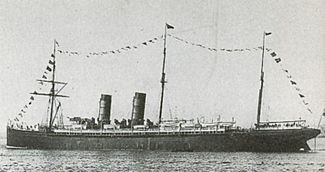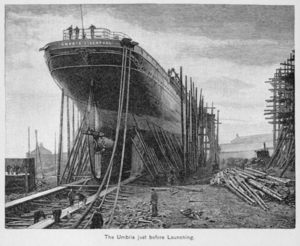RMS Umbria facts for kids

RMS Umbria on Queen Victoria's Birthday in 1896
|
|
Quick facts for kids History |
|
|---|---|
| Name | RMS Umbria |
| Namesake | Umbria |
| Owner | Cunard SS Co |
| Operator | Cunard SS Co |
| Port of registry | Liverpool |
| Route | Liverpool – Queenstown – New York |
| Ordered | 1883 |
| Builder | John Elder & Co, Govan |
| Yard number | 285 |
| Launched | 25 June 1884 |
| Maiden voyage | 1 November 1884 |
| In service | 1 November 1884 |
| Out of service | 1908 |
| Identification | |
| Fate | Scrapped 1910 |
| General characteristics | |
| Type | Ocean liner |
| Tonnage | 1884: 7,129 GRT, 3,268 NRT |
| Length | 501.6 ft (152.9 m) |
| Beam | 57.2 ft (17.4 m) |
| Depth | 38.2 ft (11.6 m) |
| Decks | 6 |
| Installed power | 1,559 NHP |
| Propulsion | 3-cylinder compound engine |
| Sail plan | barquentine |
| Speed | 19 knots (35 km/h) |
| Capacity |
|
| Crew | 560 |
The RMS Umbria was a famous ocean liner that sailed the Atlantic Ocean. She was built in 1884 for the Cunard Line, a well-known shipping company. Umbria and her sister ship, the RMS Etruria, were special because they were the last large Cunard ships to use both steam engines and sails.
Umbria was built in Govan, Glasgow, Scotland. She was one of the biggest ships of her time. Her main job was to carry passengers and mail between Liverpool, England, and New York City, USA. She made her first trip on November 1, 1884.
Contents
Building a Giant Ship
Umbria was designed to look very powerful. She had two tall funnels (smokestacks) and three large steel masts. These masts allowed her to use sails, like a barquentine sailing ship. This was unusual for a steamship of her size.
The ship also had new features like refrigeration to keep food fresh. Inside, Umbria was very fancy, showing off the luxury of the Victorian era. The first-class areas had beautiful carved furniture and velvet curtains. There were special rooms for music and smoking, plus separate dining rooms for different passenger classes. Even the second-class areas were comfortable and spacious.
Umbria was officially registered in Liverpool. After her tests, she began her first journey to New York City. Captain Theodore Cook, a very experienced captain, was in charge.
Sailing the Atlantic Route
RMS Umbria regularly sailed between Liverpool and New York City. This was a very busy route for ships. Sometimes, events in the world would cause her service to change.
When Umbria Became a Warship
In 1885, there was a brief worry about a war between the British Empire and the Russian Empire. Because of this, the British Navy decided to use Umbria as an armed merchant cruiser. This meant she was fitted with 5-inch (130 mm) guns.
Luckily, the war scare ended quickly. While her sister ship Etruria went back to normal service, Umbria stayed ready for six more months, just in case. People thought she would be a strong addition to the navy if needed.
Back to Passenger Service
In September 1885, Umbria returned to her usual job of carrying passengers across the Atlantic. For several years, she sailed without any big problems.
| Ticket Prices on RMS Umbria, May 1895 | ||||||||||
|---|---|---|---|---|---|---|---|---|---|---|
| From Pier 40, New York City, to Queenstown and Liverpool | ||||||||||
| 1st class | 1st class | 1st class | 1st class return | 1st class return | 1st class return | 2nd class cabin | 2nd class cabin | 2nd class cabin return | 2nd class cabin return | Under 1 year old |
| $75 | $90 | $175 | $125 | $150 | $315 | $40 | $45 | $75 | $85 | Free outward |
Winning the Blue Riband
In 1887, Umbria won the famous Blue Riband. This award was given to the ship that made the fastest crossing of the Atlantic. She broke her sister ship's record from the year before.
Umbria sailed from Queenstown (now Cobh) in Ireland to Sandy Hook in the USA. She completed the journey in 6 days, 4 hours, and 12 minutes. Her average speed was 19.22 knots (35.60 km/h; 22.12 mph). Her sister ship Etruria won the Blue Riband back the next year.
Collision at Sea
On November 10, 1888, Umbria was leaving New York when she crashed into another ship, the Iberia. The Iberia was a cargo steamship and sank after the collision. Umbria was blamed for the accident because she was traveling very fast, at about 17 knots (31 km/h; 20 mph).
| Records of RMS Umbria & RMS Etruria | |||||||
|---|---|---|---|---|---|---|---|
| The Blue Riband of the North Atlantic (Westbound) | |||||||
| Steamship | Date | Line | From | To | Nautical miles | Days/hours/minutes | Knots |
| RMS Etruria | 1885 (16/8- 22/8) | Cunard | Queenstown | Sandy Hook | 2801 | 6/5/31 | 18.73 |
| RMS Umbria | 1887 (29/5-4/6) | Cunard | Queenstown | Sandy Hook | 2848 | 6/4/12 | 19.22 |
| RMS Etruria | 1888 (27/5-2/6) | Cunard | Queenstown | Sandy Hook | 2854 | 6/1/55 | 19.56 |
Rescuing the Magdalena Crew
On April 12, 1890, Umbria was on her way from New York with 655 passengers. Five days later, in the middle of the Atlantic, she saw a Norwegian sailing ship called Magdalena. The Magdalena had hit an iceberg and was sinking.
Umbria rescued Captain Gunderson and his eight crew members. Before leaving their ship, the crew set fire to the Magdalena. Four days later, everyone was safely brought to Liverpool.
A Broken Propeller Shaft
On December 17, 1892, Umbria left Liverpool with 400 passengers and a lot of mail. She was supposed to arrive in New York by Christmas Day. But she didn't show up, and people started to worry.
News came on December 29 that her propeller shaft had broken. This meant her main engines stopped, and she was drifting in a strong storm. The ship's engineers worked very hard to fix the shaft. Another ship tried to tow her, but the rope broke in the storm.
Finally, on December 27, the engineers managed to fix the shaft enough for Umbria to move very slowly. She arrived in New York City late on December 31, 1892. Thousands of New Yorkers cheered her safe arrival.
Stuck on a Wreck
In May 1896, another ship had sunk a coal barge called Andrew Jackson. On June 28, 1896, Umbria was leaving New York. About an hour into her journey, she hit the sunken wreck of the Andrew Jackson and got stuck.
She stayed stuck all day. Finally, with the help of a rising tide and seven tugs, she was pulled free. People on board, including a Yale rowing team, cheered. Divers checked the ship and found no damage, so Umbria continued her trip.
Helping in the Boer War
When the Boer War started in South Africa in 1899, the British government asked Umbria for help. She was used to carry soldiers and weapons to South Africa.
She made her first trip there on January 11, 1900. She took troops to Cape Town and other ports. On her way back, she carried wounded soldiers to Southampton. After a few trips, she returned to Cunard in June 1900 and went back to her regular passenger service.
A Bomb Scare
On May 9, 1903, the New York City Police Department received a letter. It said a bomb had been placed on board Umbria. The letter claimed the bomb was meant for another ship but was put on Umbria because it had fewer women and children.
Police quickly searched the ship. They found a box with 100 lb (45 kg) of dynamite and a timer. An officer carefully lowered the box into the sea. The bomb was safely removed. The letter suggested the plot was to harm British shipping. After this scary event, Umbria finally sailed for Liverpool on May 16.
Last Journey of Umbria
By 1908, Umbria and Etruria were getting old. However, because of problems with other ships, Umbria kept sailing until 1910. Her very last trip started on February 12, 1910. She arrived back in the Mersey River for the final time on March 4, 1910.
As soon as her passengers left, workers began taking apart her insides. She was sold for scrap metal for £20,000 and taken to Bo'ness, Scotland, to be broken up. In her lifetime, Umbria made 145 round trips to New York.



